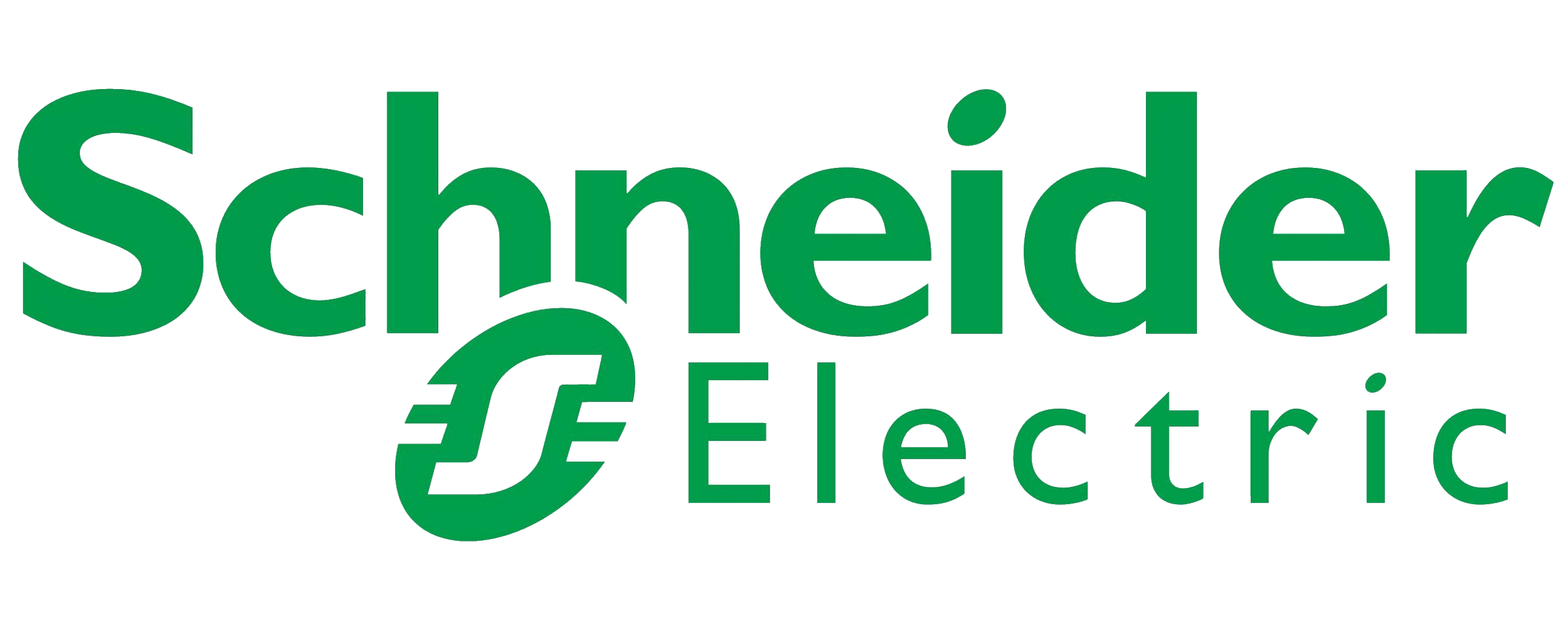Global Modular & Prefabricated Construction Market By Type, By Construction Method, By End Use Sector, By Region & Segmental Insights Trends and Forecast, 2024 – 2034
- Industry: Construction & Manufacturing
- Report ID: TNR-110-1283
- Number of Pages: 420
- Table/Charts : Yes
- September, 2024
- Base Year : 2024
- No. of Companies : 10+
- No. of Countries : 29
- Views : 10087
- Covid Impact Covered: Yes
- War Impact Covered: Yes
- Formats : PDF, Excel, PPT
Modular and prefabricated construction are innovative building methods where components or entire sections of a building are manufactured off-site in a factory setting before being transported to the construction site for assembly. According to recent statistics, the global modular & prefabricated construction market was valued at approximately USD 157.8 Bn in 2023 projected to reach USD 305.8 Bn by 2034; expected to grow at a CAGR of 6.2% from 2024 to 2034. The global modular and prefabricated construction market is experiencing significant growth due to its efficiency, cost-effectiveness, and sustainability. This construction approach involves assembling building components in a factory setting before transporting and assembling them on-site. Modular and prefabricated construction is increasingly adopted across various sectors, including residential, commercial, and industrial applications.
Residential projects benefit from faster build times and reduced labor costs, while commercial and industrial sectors leverage prefabrication for scalable and customizable solutions. The rising focus on reducing construction waste and minimizing environmental impact is driving the adoption of these methods. Enhanced technology and improved designs further fuel market expansion, making modular and prefabricated construction a popular choice for modern building projects.

Global Modular & Prefabricated Construction Market Dynamics
Global Modular & Prefabricated Construction Market Growth Driver:
Technological Advancements: Innovations in building technologies, such as 3D printing and automated manufacturing, enhance precision and efficiency in modular and prefabricated construction. These advancements reduce production times and costs, driving market growth by offering faster and more economical construction solutions.
Sustainability Focus: Increasing environmental awareness and regulations drive the adoption of modular and prefabricated construction. These methods minimize waste and reduce carbon footprints compared to traditional construction, appealing to eco-conscious developers and governments committed to sustainable building practices.
Global Modular & Prefabricated Construction Market Restraint:
High Initial Costs: The upfront investment for modular and prefabricated construction can be substantial, involving expenses for factory setup and specialized components. This can deter smaller developers and affect project feasibility, limiting widespread adoption despite long-term cost savings.
Regulatory Challenges: Variability in building codes and regulations across regions can complicate the adoption of modular and prefabricated construction. Compliance with diverse standards and obtaining necessary approvals can delay projects and increase costs, posing a barrier to market expansion.
Global Modular & Prefabricated Construction Market Opportunity:
Urbanization and Housing Demand: Rapid urbanization and rising housing needs create significant opportunities for modular and prefabricated construction. These methods offer quick, scalable solutions to address housing shortages in urban areas, providing affordable and efficient residential options.
Disaster Relief and Reconstruction: Modular and prefabricated construction can play a crucial role in disaster relief efforts by providing rapid, temporary, or permanent housing solutions. Their quick assembly and transportability make them ideal for rebuilding communities affected by natural disasters.
Global Modular & Prefabricated Construction Market Trends:
Integration of Smart Technologies: The incorporation of smart technologies and IoT (Internet of Things) into modular and prefabricated construction is on the rise. Smart modules with integrated sensors and automation systems enhance energy efficiency, safety, and functionality, driving innovation in the market.
Increased Use of Sustainable Materials: There is a growing trend towards using eco-friendly and sustainable materials in modular and prefabricated construction. The focus on green building practices and reducing environmental impact is leading to the development of materials that are both energy-efficient and recyclable.
Global Modular & Prefabricated Construction Market Segmental Analysis:
Global Modular & Prefabricated Construction Market By Type
Prefabricated construction segment, as type category, has dominated the global modular & prefabricated construction market, driven by its ability to streamline the building process through the off-site manufacturing of components like wall panels, floors, and roofs. By assembling these elements in a controlled factory environment, prefabrication reduces on-site construction time and labor costs. Additionally, it ensures higher quality control and precision, leading to fewer errors and faster project completion. The segment’s growth is further supported by its alignment with sustainability goals, as it minimizes waste and energy use, appealing to environmentally conscious developers and contributing to its market leadership.
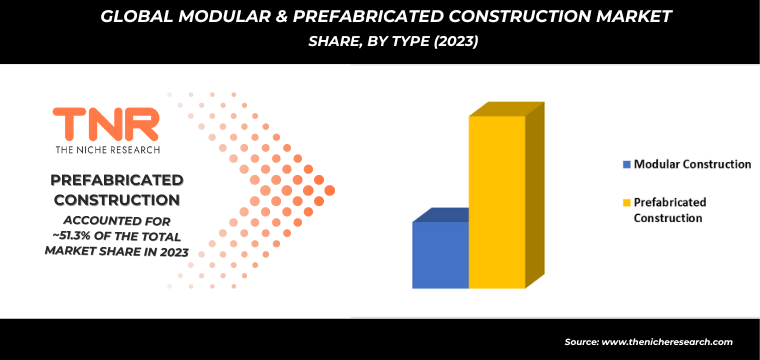
Global Modular & Prefabricated Construction Market By Construction Method
Hybrid construction segment has emerged as the fastest-growing application in the global modular & prefabricated construction market. This growth is attributed to the segment’s innovative approach of combining various building materials and methods to optimize structural performance and design flexibility. Hybrid construction integrates traditional building techniques with prefabricated components, allowing for enhanced customization and improved construction efficiency. This approach addresses the diverse needs of modern projects, offering both the speed of prefabrication and the adaptability of conventional methods. The increasing demand for versatile, high-quality buildings has fueled the expansion of hybrid construction, making it a prominent trend in the industry.
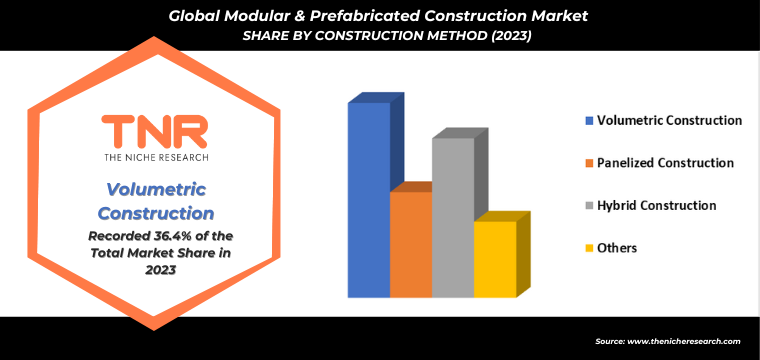
Global Modular & Prefabricated Construction Market By End Use Sector
In 2023, the commercial segment led the global modular & prefabricated construction market, accounting for a 41.6% revenue share. This dominance reflects the growing adoption of modular and prefabricated methods in constructing office buildings, retail spaces, and hotels. The commercial sector benefits from these methods’ ability to deliver high-quality, cost-effective structures with faster completion times. Prefabrication and modular construction address the increasing demand for scalable and flexible commercial spaces, accommodating evolving business needs and reducing construction disruptions. The segment’s growth is driven by the need for efficient, sustainable building solutions that meet the dynamic requirements of the commercial real estate market.
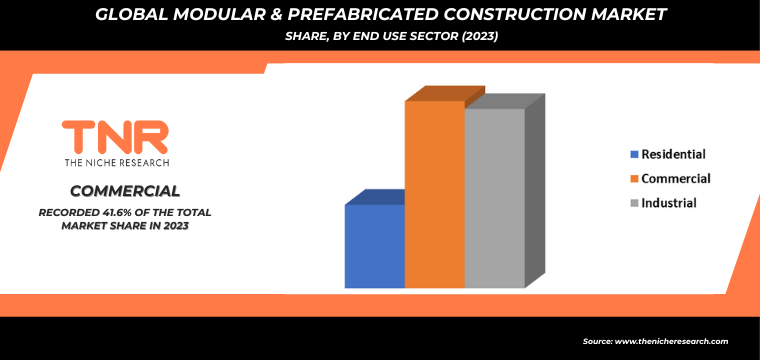
Global Modular & Prefabricated Construction Market By Region
North America held regional dominance in the global modular & prefabricated construction market, largely due to its advanced technological infrastructure and strong demand for innovative construction solutions. The region’s focus on improving efficiency and reducing construction time has driven widespread adoption of modular and prefabricated methods. Additionally, North America’s robust construction industry and substantial investment in sustainable building practices have further supported market growth. The presence of key industry players and favorable regulatory environments also contribute to the region’s leadership. North America’s emphasis on rapid urban development and addressing housing shortages with cost-effective solutions continues to reinforce its dominant position in the market.
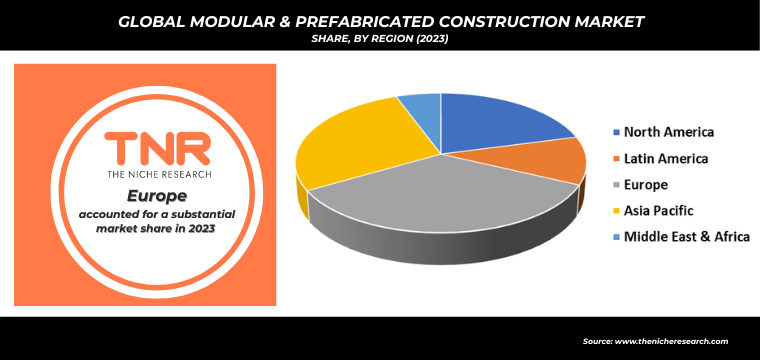
Competitive Landscape
The global modular and prefabricated construction market is highly competitive, with numerous players offering diverse solutions. Leading firms invest in technology and innovation to enhance efficiency and sustainability. Competition is driven by the need for faster construction, cost reduction, and meeting evolving customer demands.
Some of the players operating in the modular & prefabricated construction market are
- ACS Group
- Algeco (Modulaire Group)
- Berkeley Modular Limited
- Bouygues Construction
- DUB0X
- Guerdon, LLC
- Hickory Group
- Kiewit Corporation
- Kleusberg GmbH
- Laing O’Rourke
- Larsen & Toubro Limited
- Lendlease Corporation
- Red Sea International
- Riko Group
- Satellite Shelters
- Sekisui House, Ltd.
- Skanska
- Taisei Corporation
- VINCI Construction
- Other Industry Participants
Key Developments:
- In August 2021, SG Blocks Inc., known for designing and fabricating modern modular blocks, teamed up with ATCO Structures. This collaboration aims to support the national rollout of modular units across the U.S.
- In July 2021, Modulaire Group, a leading global provider of modular spaces and business areas, acquired Procomm Site Service Ltd., a company specializing in portable, modular accommodation in Europe. This acquisition enhances Modulaire Group’s position in the European market by expanding its portfolio and capabilities.
Global Modular & Prefabricated Construction Market Scope
| Report Specifications | Details |
| Market Revenue in 2023 | US$ 157.8 Bn |
| Market Size Forecast by 2034 | US$ 305.8 Bn |
| Growth Rate (CAGR) | 6.2% |
| Historic Data | 2016 – 2022 |
| Base Year for Estimation | 2023 |
| Forecast Period | 2024 – 2034 |
| Report Inclusions | Market Size & Estimates, Market Dynamics, Competitive Scenario, Trends, Growth Factors, Market Determinants, Key Investment Segmentation, Product/Service/Solutions Benchmarking |
| Segments Covered | By Type, By Construction Method, By End Use Sector, By Region |
| Regions Covered | North America, Europe, Asia Pacific, Middle East & Africa, Latin America |
| Countries Covered | U.S., Canada, Mexico, Rest of North America, France, The UK, Spain, Germany, Italy, Nordic Countries (Denmark, Finland, Iceland, Sweden, Norway), Benelux Union (Belgium, The Netherlands, Luxembourg), Rest of Europe, China, Japan, India, New Zealand, Australia, South Korea, Southeast Asia (Indonesia, Thailand, Malaysia, Singapore, Rest of Southeast Asia), Rest of Asia Pacific, Saudi Arabia, UAE, Egypt, Kuwait, South Africa, Rest of Middle East & Africa, Brazil, Argentina, Rest of Latin America |
| Key Players | ACS Group, Algeco (Modulaire Group), Berkeley Modular Limited, Bouygues Construction, DUB0X, Guerdon, LLC, Hickory Group, Kiewit Corporation, Kleusberg GmbH, Laing O’Rourke, Larsen & Toubro Limited, Lendlease Corporation, Red Sea International, Riko Group, Satellite Shelters, Sekisui House, Ltd., Skanska, Taisei Corporation, VINCI Construction |
| Customization Scope | Customization allows for the inclusion/modification of content pertaining to geographical regions, countries, and specific market segments. |
| Pricing & Procurement Options | Explore purchase options tailored to your specific research requirements |
| Contact Details | Consult With Our Expert
Japan (Toll-Free): +81 663-386-8111 South Korea (Toll-Free): +82-808- 703-126 Saudi Arabia (Toll-Free): +966 800-850-1643 United Kingdom: +44 753-710-5080 United States: +1 302-232-5106 E-mail: askanexpert@thenicheresearch.com
|
Global Modular & Prefabricated Construction Market Segmentation:
By Type
- Modular Construction
- Permanent
- Relocatable
- Prefabricated Construction
- Precast Concrete Panels
- Prefabricated Wood Panels
- Prefabricated Metal Panels
- Prefabricated Steel Panels
- Others
By Construction Method
- Volumetric Construction
- Panelized Construction
- Hybrid Construction
- Others
By End Use Sector
- Residential
- Commercial
- Industrial
By Region
- North America (U.S., Canada, Mexico, Rest of North America)
- Europe (France, The UK, Spain, Germany, Italy, Nordic Countries (Denmark, Finland, Iceland, Sweden, Norway), Benelux Union (Belgium, The Netherlands, Luxembourg), Rest of Europe)
- Asia Pacific (China, Japan, India, New Zealand, Australia, South Korea, Southeast Asia (Indonesia, Thailand, Malaysia, Singapore, Rest of Southeast Asia), Rest of Asia Pacific)
- Middle East & Africa (Saudi Arabia, UAE, Egypt, Kuwait, South Africa, Rest of Middle East & Africa)
- Latin America (Brazil, Argentina, Rest of Latin America)
Report Layout:
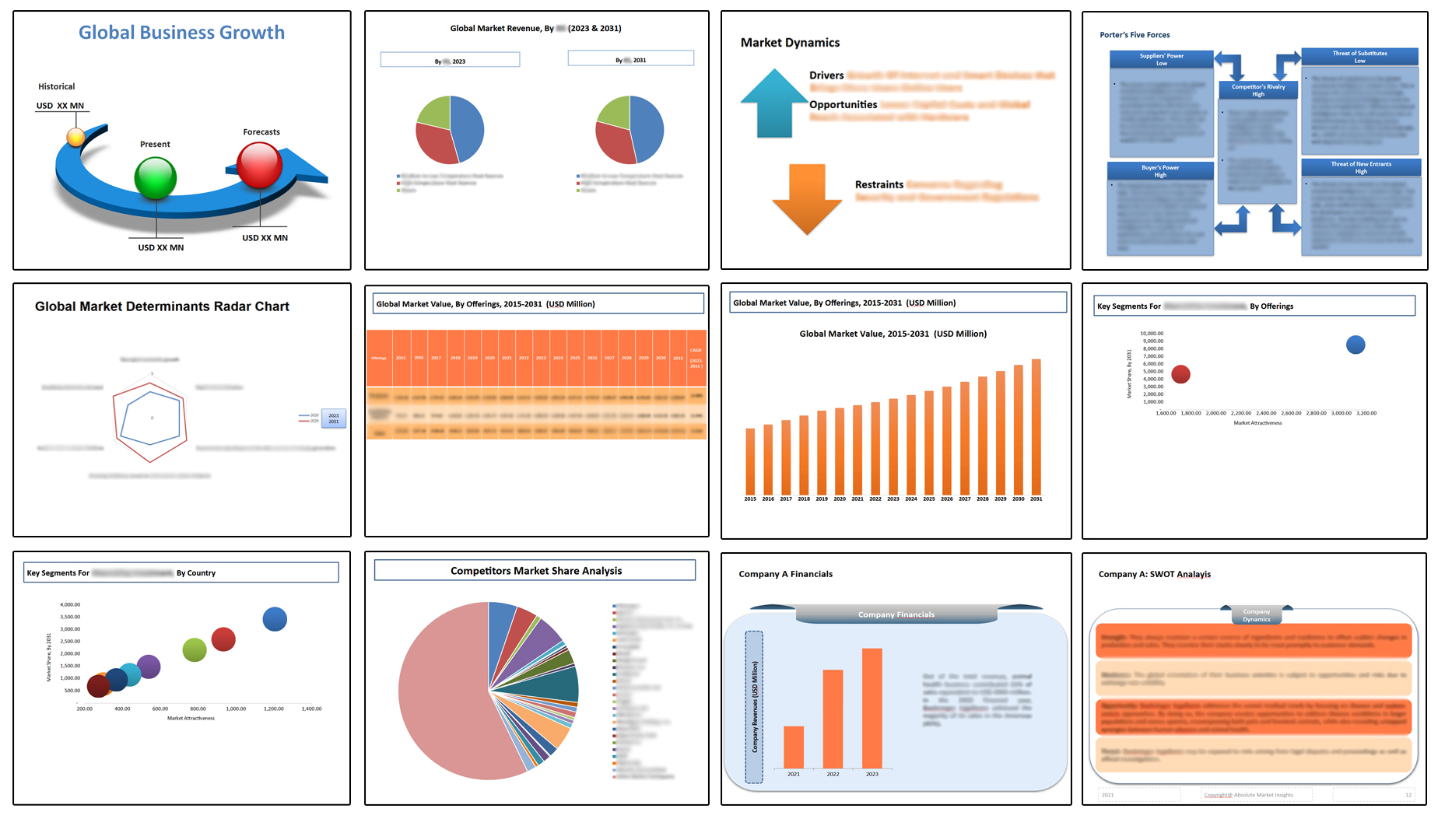
Table of Contents
Note: This ToC is tentative and can be changed according to the research study conducted during the course of report completion.
**Exclusive for Multi-User and Enterprise User.
Global Modular & Prefabricated Construction Market Segmentation:
By Type
- Modular Construction
- Permanent
- Relocatable
- Prefabricated Construction
- Precast Concrete Panels
- Prefabricated Wood Panels
- Prefabricated Metal Panels
- Prefabricated Steel Panels
- Others
By Construction Method
- Volumetric Construction
- Panelized Construction
- Hybrid Construction
- Others
By End Use Sector
- Residential
- Commercial
- Industrial
By Region
- North America (U.S., Canada, Mexico, Rest of North America)
- Europe (France, The UK, Spain, Germany, Italy, Nordic Countries (Denmark, Finland, Iceland, Sweden, Norway), Benelux Union (Belgium, The Netherlands, Luxembourg), Rest of Europe)
- Asia Pacific (China, Japan, India, New Zealand, Australia, South Korea, Southeast Asia (Indonesia, Thailand, Malaysia, Singapore, Rest of Southeast Asia), Rest of Asia Pacific)
- Middle East & Africa (Saudi Arabia, UAE, Egypt, Kuwait, South Africa, Rest of Middle East & Africa)
- Latin America (Brazil, Argentina, Rest of Latin America)
The Niche Research approach encompasses both primary and secondary research methods to provide comprehensive insights. While primary research is the cornerstone of our studies, we also incorporate secondary research sources such as company annual reports, premium industry databases, press releases, industry journals, and white papers.
Within our primary research, we actively engage with various industry stakeholders, conducting paid interviews and surveys. Our meticulous analysis extends to every market participant in major countries, allowing us to thoroughly examine their portfolios, calculate market shares, and segment revenues.
Our data collection primarily focuses on individual countries within our research scope, enabling us to estimate regional market sizes. Typically, we employ a bottom-up approach, meticulously tracking trends in different countries. We analyze growth drivers, constraints, technological innovations, and opportunities for each country, ultimately arriving at regional figures.Our process begins by examining the growth prospects of each country. Building upon these insights, we project growth and trends for the entire region. Finally, we utilize our proprietary model to refine estimations and forecasts.
Our data validation standards are integral to ensuring the reliability and accuracy of our research findings. Here’s a breakdown of our data validation processes and the stakeholders we engage with during our primary research:
- Supply Side Analysis: We initiate a supply side analysis by directly contacting market participants, through telephonic interviews and questionnaires containing both open-ended and close-ended questions. We gather information on their portfolios, segment revenues, developments, and growth strategies.
- Demand Side Analysis: To gain insights into adoption trends and consumer preferences, we reach out to target customers and users (non-vendors). This information forms a vital part of the qualitative analysis section of our reports, covering market dynamics, adoption trends, consumer behavior, spending patterns, and other related aspects.
- Consultant Insights: We tap into the expertise of our partner consultants from around the world to obtain their unique viewpoints and perspectives. Their insights contribute to a well-rounded understanding of the markets under investigation.
- In-House Validation: To ensure data accuracy and reliability, we conduct cross-validation of data points and information through our in-house team of consultants and utilize advanced data modeling tools for thorough verification.
The forecasts we provide are based on a comprehensive assessment of various factors, including:
- Market Trends and Past Performance (Last Five Years): We accurately analyze market trends and performance data from preceding five years to identify historical patterns and understand the market’s evolution.
- Historical Performance and Growth of Market Participants: We assess the historical performance and growth trajectories of key market participants. This analysis provides insights into the competitive landscape and individual company strategies.
- Market Determinants Impact Analysis (Next Eight Years): We conduct a rigorous analysis of the factors that are projected to influence the market over the next eight years. This includes assessing both internal and external determinants that can shape market dynamics.
- Drivers and Challenges for the Forecast Period:Identify the factors expected to drive market growth during the forecast period, as well as the challenges that the industry may face. This analysis aids in deriving an accurate growth rate projection.
- New Acquisitions, Collaborations, or Partnerships: We keep a close watch on any new acquisitions, collaborations, or partnerships within the industry. These developments can have a significant impact on market dynamics and competitiveness.
- Macro and Micro Factors Analysis:A thorough examination of both macro-level factors (e.g., economic trends, regulatory changes) and micro-level factors (e.g., technological advancements, consumer preferences) that may influence the market during the forecast period.
- End-User Sentiment Analysis: To understand the market from the end-user perspective, we conduct sentiment analysis. This involves assessing the sentiment, preferences, and feedback of the end-users, which can provide valuable insights into market trends.
- Perspective of Primary Participants: Insights gathered directly from primary research participants play a crucial role in shaping our forecasts. Their perspectives and experiences provide valuable qualitative data.
- Year-on-Year Growth Trend: We utilize a year-on-year growth trend based on historical market growth and expected future trends. This helps in formulating our growth projections, aligning them with the market’s historical performance.
Research process adopted by TNR involves multiple stages, including data collection, validation, quality checks, and presentation. It’s crucial that the data and information we provide add value to your existing market understanding and expertise. We have also established partnerships with business consulting, research, and survey organizations across regions and globally to collaborate on regional analysis and data validation, ensuring the highest level of accuracy and reliability in our reports.




